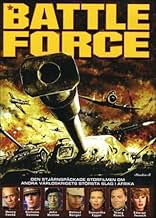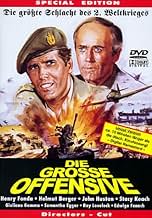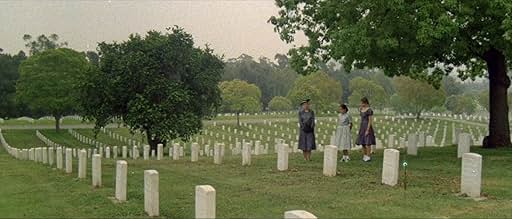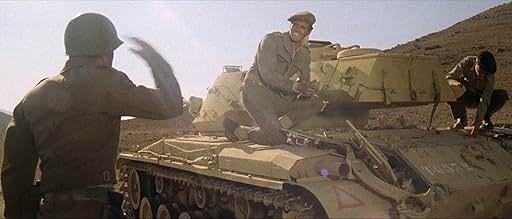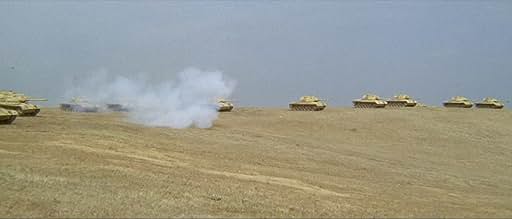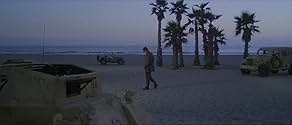AVALIAÇÃO DA IMDb
4,7/10
632
SUA AVALIAÇÃO
Adicionar um enredo no seu idiomaHow World War II affected the lives of a German family and an American family, both of whom had sons and fathers fighting in the war.How World War II affected the lives of a German family and an American family, both of whom had sons and fathers fighting in the war.How World War II affected the lives of a German family and an American family, both of whom had sons and fathers fighting in the war.
- Direção
- Roteiristas
- Artistas
Ida Galli
- Sybil Scott
- (as Evelyn Stewart)
Rik Battaglia
- French Partisan
- (as Rick Battaglia)
Avaliações em destaque
This film has the unmistakable whiff of tax write off about it and I can't believe the non-Italians in this Italian made World War II film weren't doing this one for nothing more than a paycheck and a European vacation.
For an Italian film you would think Italy would be mentioned somewhere in this story. The climax of the movie is the battle for Tunisia where the Italians had a lot of soldiers. The battle scenes are merely stock footage from other and better films.
The only tie in this whole story is a meeting in Berlin of retired army general Henry Fonda, war correspondent John Huston, German-Jewish actress Samantha Eggar and German major Stacy Keach. Meeting at the time of the Olympics there, the four dismiss the possibility of war.
After that it seems like you're watching four or five separate films all at once. Everyone seems to be just reciting the dialog by rote and hurrying off to do better things presumably. Even Orson Welles who narrates the English language version, can't whip up any excitement in his voice.
It's just another one done for the money.
For an Italian film you would think Italy would be mentioned somewhere in this story. The climax of the movie is the battle for Tunisia where the Italians had a lot of soldiers. The battle scenes are merely stock footage from other and better films.
The only tie in this whole story is a meeting in Berlin of retired army general Henry Fonda, war correspondent John Huston, German-Jewish actress Samantha Eggar and German major Stacy Keach. Meeting at the time of the Olympics there, the four dismiss the possibility of war.
After that it seems like you're watching four or five separate films all at once. Everyone seems to be just reciting the dialog by rote and hurrying off to do better things presumably. Even Orson Welles who narrates the English language version, can't whip up any excitement in his voice.
It's just another one done for the money.
Director Umberto Lenzi's movies have always been the subject of criticism on web boards and even from nationally known reviewers, including Leonard Maltin. It seems as though he takes a lot of flak simply because his films are made overseas. At its heart, "The Greatest Battle" is really no better or worse than the slew of epic war films to come out of Hollywood in the 1970s.
During the Berlin Olympics of 1936, German Major Roland (Stacy Keach); American General Foster (Henry Fonda); reporter Sean O'Hara (John Huston) and Jewish actress Annelise Ackerman (Samantha Eggar) meet and become friends. Flash forward to late 1941: America is embroiled in World War II. Several more characters are introduced, namely: Foster's loser son, John (Ray Lovelock); gutsy British commando leader Captain Scott (Giuliano Gemma) and dedicated Nazi commando officer Lt. Zimmer (Helmut Berger). All of these characters become interconnected over the course of the next two years and wind up coming face-to-face at the Battle of the Mareth Line in North Africa. Each turn in a dedicated, honest performance something to be admired in this genre.
Several familiar European actors appear in the supporting cast, and although their parts are unimportant to the storyline, it's essential to mention some of them: Giacomo Rossi-Stuart ("Hornets' Nest") plays John Foster's commander; Andrea Bosic ("Hell's Brigade") as the leader of Greek partisans; Ida Galli ("Eagles Over London") as Scott's estranged wife, and Venantino Venantini ("The War Devils") as her new husband; Geoffrey Copleston ("The Assisi Underground") as a menacing SS Colonel; Luciano Catenacci ("The Battle of El Alamein") as a British radio operator; the list goes on forever. Even Orson Welles ("The Battle of Neretva") narrates the proceedings rather unnecessarily and, often, incorrectly.
For the most part, this is a plot less series of scenes, chronicling major events in the characters' lives and campaigns. Lenzi fills out the running time with stylistic action sequences and well-integrated stock footage. Lenzi's directorial style and energy are apparent in a number of battle scenes. He takes a lot of ideas and scenarios from his earlier war films notably, "Battle of the Commandos" (a partisan ambush of a German armored convoy looks awfully familiar, as does a commando raid on a coastal bunker) and shoots them with a bigger budget and more professionalism. The Federico Zanni photography is simply dazzling and excellently edited by Eugenio Alabiso, one of my favorite genre-editors.
Unfortunately, a lot of familiar stock footage from "Battle of the Commandos", "Commandos", "Desert Assault" and "The Battle of El Alamein" is used as a substitute for original action footage, which really hampers the original, epic feel of the movie. But look at Hollywood's epic "Midway" released in 1976: it's a hodgepodge of stock footage and cameos, yet is much better received by audiences than this film. The major action sequences revolve solely around the stock footage, but that's okay in this movie, because the material surrounding these sequences is so good.
The production values are amazingly high in this film, setting it another notch among its' peers. The sets, from Parisian bars and brothels, to huge entrenchments, fuel dumps and railroad stations look fantastic. The costumes and props are appropriate, too. There are hundreds of extras, tanks, APCs, jeeps and airplanes dotting the screen, giving the film the appropriate epic look.
This Italian-produced war epic is typically underrated and undeserving of the criticism it so often receives. While it does lack a storyline and has no character development whatsoever and contains reels of stock footage, the original material, style and slew of actors help to offset these flaws. "The Greatest Battle" is no better or worse than any similar film made in Hollywood, and is certainly much more entertaining and engaging than titles like "Midway".
During the Berlin Olympics of 1936, German Major Roland (Stacy Keach); American General Foster (Henry Fonda); reporter Sean O'Hara (John Huston) and Jewish actress Annelise Ackerman (Samantha Eggar) meet and become friends. Flash forward to late 1941: America is embroiled in World War II. Several more characters are introduced, namely: Foster's loser son, John (Ray Lovelock); gutsy British commando leader Captain Scott (Giuliano Gemma) and dedicated Nazi commando officer Lt. Zimmer (Helmut Berger). All of these characters become interconnected over the course of the next two years and wind up coming face-to-face at the Battle of the Mareth Line in North Africa. Each turn in a dedicated, honest performance something to be admired in this genre.
Several familiar European actors appear in the supporting cast, and although their parts are unimportant to the storyline, it's essential to mention some of them: Giacomo Rossi-Stuart ("Hornets' Nest") plays John Foster's commander; Andrea Bosic ("Hell's Brigade") as the leader of Greek partisans; Ida Galli ("Eagles Over London") as Scott's estranged wife, and Venantino Venantini ("The War Devils") as her new husband; Geoffrey Copleston ("The Assisi Underground") as a menacing SS Colonel; Luciano Catenacci ("The Battle of El Alamein") as a British radio operator; the list goes on forever. Even Orson Welles ("The Battle of Neretva") narrates the proceedings rather unnecessarily and, often, incorrectly.
For the most part, this is a plot less series of scenes, chronicling major events in the characters' lives and campaigns. Lenzi fills out the running time with stylistic action sequences and well-integrated stock footage. Lenzi's directorial style and energy are apparent in a number of battle scenes. He takes a lot of ideas and scenarios from his earlier war films notably, "Battle of the Commandos" (a partisan ambush of a German armored convoy looks awfully familiar, as does a commando raid on a coastal bunker) and shoots them with a bigger budget and more professionalism. The Federico Zanni photography is simply dazzling and excellently edited by Eugenio Alabiso, one of my favorite genre-editors.
Unfortunately, a lot of familiar stock footage from "Battle of the Commandos", "Commandos", "Desert Assault" and "The Battle of El Alamein" is used as a substitute for original action footage, which really hampers the original, epic feel of the movie. But look at Hollywood's epic "Midway" released in 1976: it's a hodgepodge of stock footage and cameos, yet is much better received by audiences than this film. The major action sequences revolve solely around the stock footage, but that's okay in this movie, because the material surrounding these sequences is so good.
The production values are amazingly high in this film, setting it another notch among its' peers. The sets, from Parisian bars and brothels, to huge entrenchments, fuel dumps and railroad stations look fantastic. The costumes and props are appropriate, too. There are hundreds of extras, tanks, APCs, jeeps and airplanes dotting the screen, giving the film the appropriate epic look.
This Italian-produced war epic is typically underrated and undeserving of the criticism it so often receives. While it does lack a storyline and has no character development whatsoever and contains reels of stock footage, the original material, style and slew of actors help to offset these flaws. "The Greatest Battle" is no better or worse than any similar film made in Hollywood, and is certainly much more entertaining and engaging than titles like "Midway".
I don't understand how Luciano Martino and Mino Loy were able to raise the money to hire so many big-name actors of the time (such as Orson Welles, John Huston, Henry Fonda, and Samantha Eggar) but they still had to rely on plentiful stock footage from earlier war movies like THE BATTLE OF EL ALAMEIN and LEGION OF THE DAMNED. Pretty much all the substantial action scenes featured here consist of lifted shots from late 60's films, giving it an overall dated appearance.
Umberto Lenzi's directing is good as usual, with lots of emphasis placed on the well-edited action scenes. The budget for production design and extras casting appears minimal however, with a lot of the same actors dying over and over again, and a few really shoddy toy tanks exploding.
As for the cast, just about everybody that had anything to do with the Italian movie industry shows up somewhere in the movie, from familiar dubbing voice Robert Spafford as Patton to future director Michele Soavi as Fonda's dead son. The photography and music are all top notch, yet this movie has gotten ad reviews across the board. Why? My guess is that it's because it has little or no plot to speak of. There are so many characters and so much going on in the film that it has no focus or direction. Eggar's character has no point in the movie other than she makes it slightly longer, and Edwige Fenech gets one lousy scene as a French prostitute. Eventually, most of the actors end up in Africa fighting on one side or the other and (surprise!) the Germans lose and all the German characters die, the end. But who goes to watch a good old-fashioned war movie for the plot anyway? There's plenty to enjoy if you like watching German soldiers lying in the road pretending to be dead so they can shoot the American soldiers that run up to help them. It also contains a number of memorable scenes like when Stacy Keach gets lost in the desert and falls over after about 10 seconds of walking, and a very irritating case of bad communication when Ray Lovelock attempts to call up his father and the two barely manage to get through even a few words.
The ending really comes out of nowhere though, but it's made especially funny as John Huston seems to just get bored of the movie and walk off saying "seeya around" right into the camera! The extended European cut at least provides a little more closure and overall much less disjointed, though it's missing the Orson Welles narration which so desperately tries to tie everything together. Definitely not a movie to miss... for fans of the Italian war movie sub-genre and those curious to see a sort of dry run for the WINDS OF WAR miniseries.
Umberto Lenzi's directing is good as usual, with lots of emphasis placed on the well-edited action scenes. The budget for production design and extras casting appears minimal however, with a lot of the same actors dying over and over again, and a few really shoddy toy tanks exploding.
As for the cast, just about everybody that had anything to do with the Italian movie industry shows up somewhere in the movie, from familiar dubbing voice Robert Spafford as Patton to future director Michele Soavi as Fonda's dead son. The photography and music are all top notch, yet this movie has gotten ad reviews across the board. Why? My guess is that it's because it has little or no plot to speak of. There are so many characters and so much going on in the film that it has no focus or direction. Eggar's character has no point in the movie other than she makes it slightly longer, and Edwige Fenech gets one lousy scene as a French prostitute. Eventually, most of the actors end up in Africa fighting on one side or the other and (surprise!) the Germans lose and all the German characters die, the end. But who goes to watch a good old-fashioned war movie for the plot anyway? There's plenty to enjoy if you like watching German soldiers lying in the road pretending to be dead so they can shoot the American soldiers that run up to help them. It also contains a number of memorable scenes like when Stacy Keach gets lost in the desert and falls over after about 10 seconds of walking, and a very irritating case of bad communication when Ray Lovelock attempts to call up his father and the two barely manage to get through even a few words.
The ending really comes out of nowhere though, but it's made especially funny as John Huston seems to just get bored of the movie and walk off saying "seeya around" right into the camera! The extended European cut at least provides a little more closure and overall much less disjointed, though it's missing the Orson Welles narration which so desperately tries to tie everything together. Definitely not a movie to miss... for fans of the Italian war movie sub-genre and those curious to see a sort of dry run for the WINDS OF WAR miniseries.
4emm
For a low-budget movie set during World War II, it does have a rough and violent edge. Above all, BATTLE FORCE surrenders to a non-existent plot and storyline that's been duped hundreds of times repeatedly. Don't expect much here as there's no specific meaning. Explosions and body counts are nothing new! Adding to the troop casulty count is of Orson Welles' annoying and interrupting narration, making it feel like a made-for-television documentary. War movies are instant classics in the grade "A" Hollywood circuit, and SAVING PRIVATE RYAN triumphs realism today. Despite a fairly good replica of those WW2 days, BATTLE FORCE is another run-of-the-mill production without enough substance. Anyone who grew up watching Hollywood war dramas in their lifetimes probably avoided this one while history was made.
I'm not a fan of war films to say the least and if I'm going to sit down and watch one, there generally has to be a real good reason for doing so. Despite the fact that Battle Force is a largely unknown and inconsequential war film from the late seventies; I actually did have several good reasons for seeing it. Anything directed by Umberto Lenzi is automatically worth watching considering all the great cult films he has delivered; from some of the best Giallo's to the very best of the Polizi genre, and adding to that is absolutely mouth-watering cast. However, in spite of those things; this is still a highly disappointing and really rather rubbish movie. The plot is rather confusing and doesn't make much sense and mainly focuses on two families of different nationalities during World War Two. However, we also focus on the actual war itself and various battles that the characters are involved in and this all gets mingled in with the stories of the families...
The main problem with this film is that it tries to do too much and the one hundred minute running time is simply not long enough for it to do it all in (although I am thankful that the film didn't last for longer!). I don't really know how credible Umberto Lenzi was as a director in 1978 (probably more credible than he was in the eighties), but somehow he has managed to get his hands on a magnificent cast chequered with stars - and not just cult stars! Big names such as John Huston, Henry Fonda and Orson Welles have roles alongside cult stars such as Ray Lovelock, Samantha Eggar, Evelyn Stewart, Stacy Keach, Helmut Berger and Edwige Fenech (who really doesn't appear for long enough). This cast is all well and good but unfortunately it's wasted. The plot lacks any sort of direction and the film might actually have been better as an anthology style movie with a few different but focused stories. The war scenes look extremely cheap (the budget was probably spent on paying stars' wages) and that also brings the film down, although there is plenty of action. Overall, this did actually have the potential to be a masterpiece; but to say the least, it isn't! Recommended for its cult value only.
The main problem with this film is that it tries to do too much and the one hundred minute running time is simply not long enough for it to do it all in (although I am thankful that the film didn't last for longer!). I don't really know how credible Umberto Lenzi was as a director in 1978 (probably more credible than he was in the eighties), but somehow he has managed to get his hands on a magnificent cast chequered with stars - and not just cult stars! Big names such as John Huston, Henry Fonda and Orson Welles have roles alongside cult stars such as Ray Lovelock, Samantha Eggar, Evelyn Stewart, Stacy Keach, Helmut Berger and Edwige Fenech (who really doesn't appear for long enough). This cast is all well and good but unfortunately it's wasted. The plot lacks any sort of direction and the film might actually have been better as an anthology style movie with a few different but focused stories. The war scenes look extremely cheap (the budget was probably spent on paying stars' wages) and that also brings the film down, although there is plenty of action. Overall, this did actually have the potential to be a masterpiece; but to say the least, it isn't! Recommended for its cult value only.
Você sabia?
- Erros de gravaçãoIn one of the scenes the American Flag has fifty stars, as it does now, but that flag was not adopted until Monday, July 4, 1960. The flag that should have been shown, which the Americans during World War Two served under, was the forty eight-star Stars and Stripes, which was valid from Thursday July 4, 1912 to Friday July 3, 1959, and is even seen hanging high in Grand Central Station in Hitchcock's North by Northwest.
- Citações
German in Danielle's room: A French whore should work with her hips and not her lips!
- Versões alternativasThe American release has been dubbed into English. The titles have been translated to English. However, on the Direct Source Special Products Home Video Release, the film remains dubbed in English, yet the opening and ending titles have been redone using modern computer technology. The opening features the title BATTLE FORCE, and credits the film's director Humphrey Longan as Humphrey Logan; credits actress Edwige Fenech as Edwige French; and claims the cast listing to be in alphabetical order, which it is not.
- ConexõesEdited from A Legião Dos Malditos (1969)
Principais escolhas
Faça login para avaliar e ver a lista de recomendações personalizadas
- How long is The Biggest Battle?Fornecido pela Alexa
Detalhes
- Data de lançamento
- Países de origem
- Idiomas
- Também conhecido como
- The Biggest Battle
- Locações de filme
- Veneza, Califórnia, EUA(beach scenes)
- Empresas de produção
- Consulte mais créditos da empresa na IMDbPro
Contribua para esta página
Sugerir uma alteração ou adicionar conteúdo ausente

